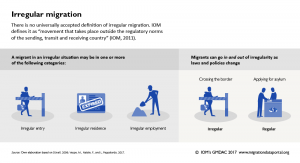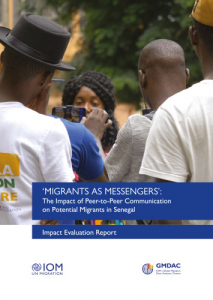Data from the International Organization for Migration (IOM)’s Missing Migrants Project reveals that attempted crossings of the Mediterranean Sea into the European Union (EU) have increased since the COVID-19 pandemic hit in 2020. According to the data, in the first eight months of 2022, about 159,000 attempted crossings were counted. Compared to the same period in 2019, there were almost 101,100.
Due to ongoing conflict, degrading environmental conditions, and the absence of safe migration pathways and local livelihood options, thousands of people risk their lives each year to seek a better life elsewhere. Information campaigns aim to target potential or actual migrants on the move to increase awareness of the dangers of irregular migration, promote the use of regular migration pathways and local livelihood opportunities.
These information campaigns are one of the most used policy tools for European governments in migration management. Between 2014 and 2019, EU member states funded 104 campaigns, and dedicated over €23 million to information campaigns after 2015.
Awareness-raising campaigns on the risks of irregular migration: What do we know about their impact?
While information campaigns have been widely used and well-funded, there are still many knowledge gaps, about their effectiveness in changing attitudes and behaviours, according to an IOM literature review. To increase the available evidence, IOM Global Migration Data Analysis Centre (GMDAC) has evaluated the impact of awareness-raising campaigns in Guinea, Senegal, and online ads on Facebook). A summary of recent research from these studies shows that:
- Potential migrants that intend to move irregularly tend to be aware of the risks they would face along the route but also tend to overestimate the chances of making it to the destination country and finding the expected job opportunities;
- There is a demand by potential migrants for better information on migration;
- Participating in awareness-raising events can affect potential migrants’ risk perceptions and intentions to migrate irregularly.
IOM awareness-raising campaigns evaluated
To contribute to the growing body of research, IOM GMDAC is conducting rigorous impact evaluation studies on two information campaigns: Migrants as Messengers (MaM) and Community Conversations (CC). These campaigns use an innovative approach by relying on peer-to-peer messaging instead of traditional top-down approaches.
- Implemented in seven countries in West Africa, MaM leverages returned migrant volunteers who share testimonials of their migration experiences with their communities.
- Implemented mostly in rural Ethiopia, where information is shared through word of mouth, CC engages with influential local leaders (teachers, religious leaders, and youth and women's groups) in community forums to disseminate messages about local livelihoods, regular migration pathways and irregular migration risks.
Methods to assess the impact of information campaigns
IOM GMDAC is assessing both campaigns with rigorous impact evaluation methods. The research aims to understand to which degree awareness-raising campaigns may change knowledge on migration and risk attitudes. By mid-2023, the studies are expected to become available to the broader practitioner and policy community. Data will be made available to the general public. Currently, research is being conducted in five countries with large survey samples. The table below summarizes the countries where the campaigns take place, the impact evaluation identification of effects methods and sample size.
|
Country and regions |
Identification method |
Sample size |
IOM campaign assessed |
|
Ethiopia: Oromia, Amhara, Southern Nations, Nationalities, and Peoples' Region |
Clustered observational study[1] |
230 enumeration areas 5700 individuals
|
Community Conversations |
|
Nigeria: Lagos State |
Cluster randomised controlled trial (CRCT)[2] |
93 enumeration areas 3235 individuals |
Migrants as Messengers |
|
Senegal: Thiès Region |
CRCT |
81 enumeration areas 3019 individuals |
Migrants as Messengers |
|
Guinea: Kankan Region |
CRCT |
80 enumeration areas 3901 individuals |
Migrants as Messengers |
|
The Gambia: Upper River Region |
CRCT |
80 enumeration areas 3858 individuals |
Migrants as Messengers |
Note: All respondents are aged 18 to 39.
Increasing the awareness of regular migration pathways: What do data tell us?
Baseline data are collected in five countries. According to the survey results, there is a considerable variation in the intentions to migrate. While most of the respondents in Nigeria, The Gambia and Senegal are considering migrating, less than two in ten adults in Ethiopia and Guinea said they intend to do so. Intentions to move without documents are low. Less than one in ten respondents across the five countries would migrate without documents.
Way forward: Is information enough to support safer migration?
The upcoming reports from GMDAC will provide much-needed evidence on the reach and limitations of the awareness-raising campaigns. While information campaigns are one of the foremost policy tools to promote safer decision-making on migration and may raise awareness of the risks of irregular migration, there should be efforts to develop local livelihoods and circular migration regimes, including safer migration pathways accessible for less-skilled migrants between receiving and sending countries.










